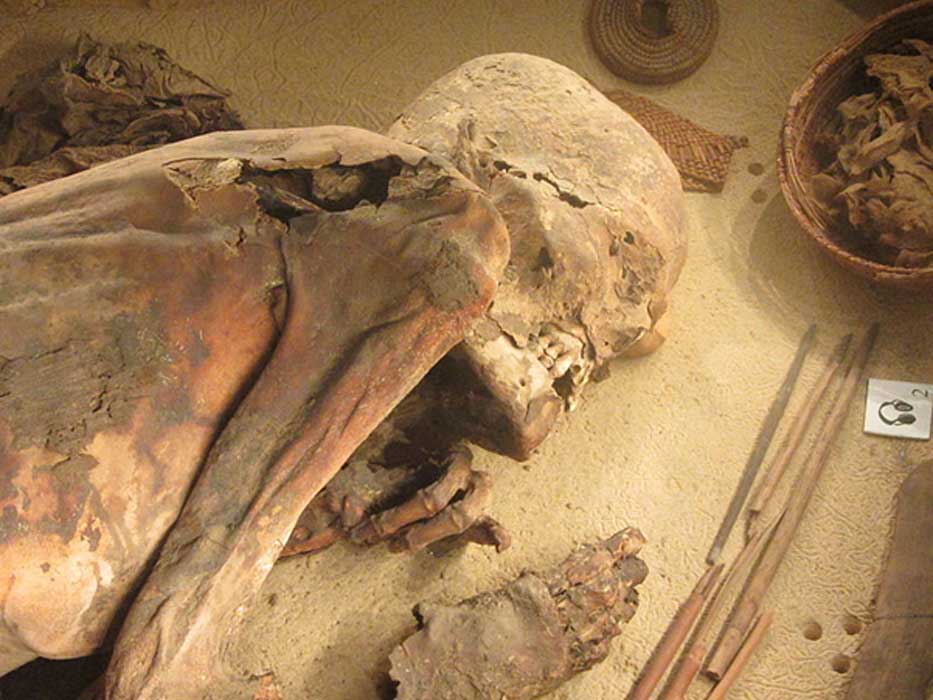Prehistoric UV Cream Discovered on Mummy Makes Him the Oldest Embalmed Egyptian By Far
The Turin mummy, or “Fred,” as it has become known to archaeologists, has been housed in Turin's Egyptian Museum since the early 1900s and remained unstudied by scientists. Dating to 3,600 years ago and curled in the fetal position, the mummy was first thought to have been “created by chance” but new evidence suggested to scientists that the Turin mummy was no accident.
A study published today in the Journal of Archaeological Science is the accumulation of a decade of work focused on prehistoric mummies by the study’s co-author Jana Jones, an Egyptologist at Macquarie University. Her team successfully tested the mummy and found a complex list of ingredients used during the embalming process, and Jones told reporters “the salve had a base of plant oils that was then mixed with plant gum or sugars, heated conifer resin, and aromatic plant extracts” according to an article in National Geographic.

Remains of the oldest Egyptian in the world, Turin’s Egyptian Museum, Italy. (CC BY-SA 3.0)
This particular list of ingredients is causing such a stir because it’s the earliest known Egyptian embalming salve. However, it is remarkably similar to the later salves used on deceased nobles and their perceived journeys into the afterlife. Speaking about this observation, the components of the paste, said Jones, “not only resemble those used thousands of years later in Egypt, but they also bear a striking similarity to the chemistry of the salve researchers had identified in the prehistoric mummy wrappings.”
Stuart Tyson Smith, an archaeologist from the University of California, Santa Barbara, who was not part of the study team, told reporters “It's really interesting to see those connections and it gives us a nice piece of the puzzle that we didn't have before.”
Previously it was thought that the mummification of the older mummies has occurred naturally due to the dry climate and sand. But now we know even the most ancient Egyptian dead had a little helping human hand to slow the aging process.
- Did Egyptian Mummification Descend from a More Ancient and, Perhaps, Reversible Preservation Technique?
- Walk Like An Egyptian… Scientists Preserve Modern Human Leg using Ancient Egyptian Methods
- Ancient Egyptian Couple Underwent Different Mummification Practice that Preserved their Organs

The material for chemical analysis was taken form the wrappings. (Image: ©Fotolia)
Jones first peered at the wrappings under a microscope almost 10 years ago and she "was astounded” to find the “cloths appeared to contain remnants of an embalming resin, a compound commonly seen in later mummies.” “It was just an incredible feeling” she said. However, to actually prove that Egyptians embalmed their dead thousands of years earlier than previously thought, almost a decade of chemistry oriented projects was undertaken.
According to an article in PHYS.org "By combining chemical analysis with visual examination of the body, genetic investigations, radiocarbon dating and microscopic analysis of the linen wrappings, we confirmed that this ritual mummification process took place around 3600 BC on a male, aged between 20 and 30 years when he died,” said Jones.
Professor Tom Higham, Deputy Director Oxford Radiocarbon Accelerator Unit, said:
"There are very few mummies of this 'natural' type available for analysis. Our radiocarbon dating shows it dates to the early Naqada phase of Egyptian prehistory, substantially earlier than the classic Pharaonic period, and this early age offers us an unparalleled glimpse into funerary treatment before the rise of the state.”
The results will significantly change our understanding of the development of mummification in ancient Egypt, and, Higham added “the use of embalming agents and demonstrate the power of interdisciplinary science in understanding the past."
- Modern version of ancient Egyptian practice of mummification now available
- Egyptologists Find 4,000-year-old Dried Heart, 50 Embalming Jars and Mummification Materials of Ancient Vizier
- The 7,000-Year-Old Chinchorro Mummies of the Andes

The mummy dates from Egyptian prehistory, before the classic Pharaonic period. (Image: ©Fotolia)
How was the embalming paste used?
Jones said, “The balm would have formed sort of a sticky brown paste,” and would have been used as a dip for bandages before wrapping, or possibly the embalmer smeared the paste directly onto the body. After the body had been entirely wrapped, the mummy was taken to a chosen spot in the hot desert. Evidently, the embalmers had calculated the effects of prolonged heat from the sun on their embalming paste, and successfully created a substance that they believed would best keep the body most intact.
Prehistoric “anti-uv” and “anti-bacterial” balms were developed over time as the mummification process became ever increasingly more ritualized and later classic mummies were interred in tombs deep below the earth’s surface, as far from the sun’s rays as possible. Because of this, archaeological chemist and mummification expert, Dr. Stephen Buckley, from the University of York says, “the embalmers had to take additional measures, such as removing the brain and other organs, as well as desiccating the body with a type of salt called natron,” according to the PHYS.org article.
And attempting to answer “how” ancient Egyptians had figured out the embalming recipe so long ago, Buckley speculated: “Some of these ingredients may well have had a symbolic significance initially… But then they noticed that they had a preservative benefit.” The archaeological and chemistry teams are now studying “sites of early experimentation with embalming ingredients,” says Buckley, and these findings will no doubt be published in a future paper.
Top image: Turin Mummy, known as ‘Fred’, Egypt Museum of Turin. Source: CC BY-SA 3.0
By Ashley Cowie



















